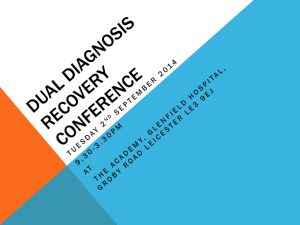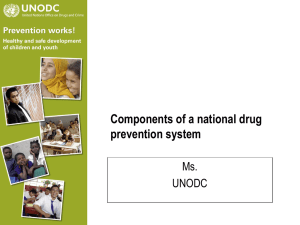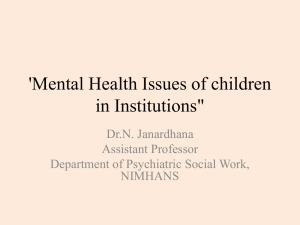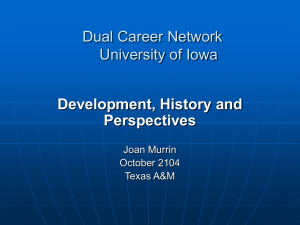Integrated Dual Diagnosis Treatment Model
advertisement
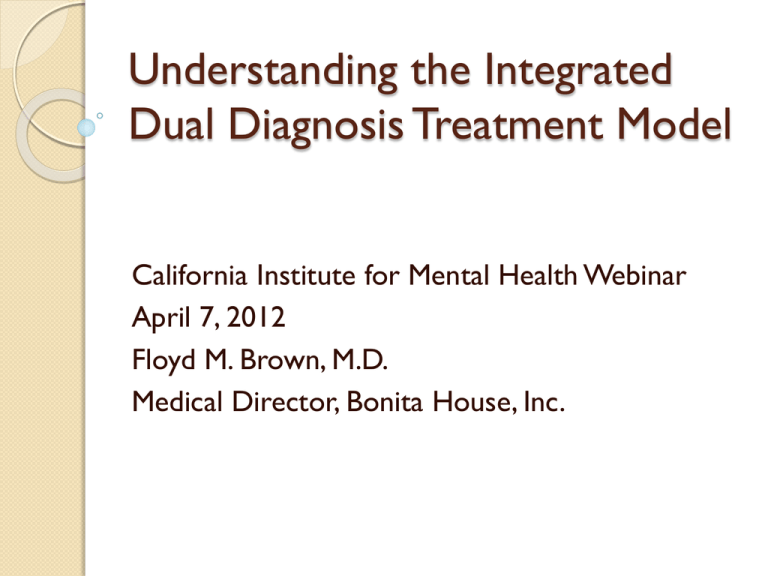
Understanding the Integrated Dual Diagnosis Treatment Model California Institute for Mental Health Webinar April 7, 2012 Floyd M. Brown, M.D. Medical Director, Bonita House, Inc. TODAY’S SPEAKER Floyd M. Brown, M.D. 2 Objectives Understand the benefits of integrated treatment for co-occurring mental health and substance use disorders. Understand the elements of the Integrated Dual Diagnosis Treatment model. Understand the relationship of evidence based practice to the emerging recovery movement. Understand how Mental Health Boards can assist in the development and evaluation of integrated treatment at the system and program levels. 3 Disclosures The speaker is Medical Director of Bonita House, Inc., a community-based non-profit organization headquartered in Oakland, CA. No commercial affiliations. 4 Bonita House, Inc. Programs Dual Diagnosis Residential Treatment Program Supported Independent Living Case Management Creative Wellness Center Homeless Outreach Stabilization Team Choices Housing Program 5 Definitions Dual Diagnosis: Co-occurring substance use disorder (SUD) and mental illness (MI). COD/COC: Co-occurring disorders/conditions (mental illness + substance use disorder) IDDT: Integrated Dual Diagnosis Treatment SPMI: Serious and persistent mental illness (e.g.; schizophrenia, bipolar, schizoaffective, major depression, etc.) 6 Definitions Dual diagnosis capable (DDC): all programs should have basic capability to assess and provide treatment or referral services to persons living with dual disorders. Dual diagnosis enhanced (DDE): programs with special capacity to serve individuals with more severe mental health and substance abuse issues (such as IDDT trained teams). 7 Case Example John S. is a 20 y/o male with a history of crack cocaine use who presented at a local mental health service seeking help because of persistent and disturbing voices. ◦ In a traditional mental health clinic John was told he had a drug problem and the psychiatrist told him he could not be given medication until he was clean and sober for 3 months. 8 Case Example John made an appointment at a local substance abuse treatment center. ◦ When the intake counselor learned of his voices John was told he was too psychiatrically ill for treatment and told he needed mental health treatment. ◦ If you were John what would you do? Have any of you who are mental health consumers or who are family members of someone living with a mental illness had similar experiences? 9 Why Integrated Treatment? After multiple hospitalizations, including a suicide attempt, John was referred to Bonita House, Inc. ◦ He was assigned to a case manager, who assisted John in finding housing and applying for benefits even though he had not given up cocaine. ◦ He was seen by a psychiatrist who offered an antipsychotic medication, which helped reduce his voices, even though John was not ready to stop using. ◦ Over time John’s drug use diminished and his voices became more manageable. 10 Integrated Treatment Consumer choice is an important aspect of the IDDT model. What happens if John was not open to taking medications? ◦ Assess for safety (self/others). ◦ Assess John’s most pressing concerns and offer to provide appropriate services based on his needs. ◦ Offer continuing service even if medications are refused. ◦ Provide psychoeducation about treatment options, including medication, if indicated. 11 Integrated Dual Diagnosis Treatment At Bonita House, Inc. we treat persons living with severe mental illness and substance abuse using the evidence-based Integrated Dual Diagnosis Treatment (IDDT) model developed at Dartmouth University by Dr. Robert Drake and others. 12 SAMHSA Evidence Based Practices Integrated Dual Diagnosis Treatment Supported Employment Assertive Community Treatment Family Psychoeducation Illness Management and Recovery Toolkits available at www.samhsa.gov. 13 IDDT: Bringing Cultures Together 14 Traditional MH and AOD Philosophical and Clinical Differences Addiction Treatment Mental Health Treatment Peer counselor model Medical/professional model Spiritual recovery Scientific treatment Self-help Medication Confrontation and expectation Support and flexibility Detachment/empowerment Case management/care Episodic treatment Continuous treatment Recovery ideology Deinstitutionalization ideology Psychopathology secondary to addiction Addiction secondary to psychopathology Relapse results in denial of service Relapse results in increased service 15 New Directions for Mental Health Treatment The emerging treatment paradigm is influenced by 3 trends: ◦ The Recovery Model, which is heavily influenced by consumer input. ◦ Evidence-based medicine (based on the most current available research outcomes). ◦ Integration of mental health, substance abuse and primary care. We believe that programs can be both recovery oriented and rely on evidence based technology. 16 Integrated Care: Expect Complexity While Dual Diagnosis is used to refer to cooccurring MI and SUD, comprehensive integrated care also includes addressing other health issues as well. Statistics show that persons living with chronic, serious mental illnesses are at high risk for chronic medical conditions and a reduced lifespan. BHI has developed partnerships with Lifelong Medical Care to improve access to primary care. 17 How Are IDDT Mental Health Programs Different? Anticipate the presence of dual disorders. Staff are trained to assess for the presence of both disorders and a multidisciplinary treatment team trained to treat both conditions provides services. Consumer choice is paramount. Shared decision making and individualized, collaborative treatment planning includes consumer, family, and provider input. 18 How Are IDDT Mental Health Programs Different? Stage based treatment. Spirituality and self-help groups are utilized. Treatment is time unlimited. Psychopharmacologic (medication) treatments are not dependent on total abstinence. Strength based approach. 19 How Are IDDT Mental Health Programs Different? Respectful, non-judgmental, hopeful, and welcoming. IDDT model programs, like all behavioral health services, should be culturally informed, sensitive, and should strive to develop cultural competency. Goals are to reduce harm first and to assist consumers to achieve recovery. 20 What Is Recovery? Surgeon General David Satcher wrote: "Recovery is variously called a process, an outlook, a vision, a guiding principle. There is neither a single agreed-upon definition of recovery nor a single way to measure it. But the overarching message is that hope and restoration of a meaningful life are possible, despite serious mental illness.” (The President’s New Freedom Commission on Mental Health, 2003) 21 “Believing You Can Recover is Vital to Recovery” (Daniel Fisher, M.D., PhD., ED, National Empowerment Center) “Illnesses don’t recover, people do” Mark Ragins, M.D. (Medical Director, The Village, Long Beach, CA) “Recovery is rediscovering meaning and purpose …It is a process, a way of life, an attitude, and a way of approaching the day’s challenges…” (Pat Deegan, Ph.D., recovery advocate) 22 How Do You Define Recovery? 23 Cultural Competency Does the IDDT model apply to California’s diverse population? CIMH evaluation of 5 programs statewide found no evidence that IDDT is less effective for minority clients being served in mixed ethnicity outpatient clinics. However even with modifications, monolingual clients in a site serving a predominately Latino population had comparatively poorer outcomes. ◦ (Chandler et al, CIMH, 2007) 24 Consumer Employment: Opportunities and Challenges Unlike mental health programs, addiction treatment services have traditionally been delivered by peer counselors but licensure or certification is becoming an expectation. IDDT-based programs present an excellent opportunity to integrate trained consumers and/or family members as full team members. Issues to consider: ◦ ◦ ◦ ◦ Role (peer/family specialist vs. generalist) Training and prior experience requirements Lived experience vs licensure (billing/reimbursement) Documentation requirements (MediCal) 25 Co-Occurring Disorders are Common Lifetime prevalence of substance abuse in persons with severe mental illness is estimated between 40-60%. (Mueser, Nordsy, Drake, Fox, Integrated Treatment of Dual Disorders: A Guide to Effective Practice, 2003) Lifetime prevalence of substance abuse in the general population is about 17% (ECA study) (Regier et al, JAMA, 1990)I (Clarification: in the following 2 slides the legend identifies MDD=major depressive disorder and MD=major depression; refers to same diagnostic condition) 26 Lifetime Prevalence (%) of Substance Use Disorder Regier, et al, JAMA, 1990 (ECA) 27 Lifetime Prevalence (%) of Any Alcohol or Drug Use Disorder Regier, et al, JAMA, 1990 (ECA) 28 Adverse Outcomes Associated with Co-Occurring SMI and SUD Increased risk of psychiatric relapse and hospitalization Unemployment/poverty Increased risk of incarceration Family/interpersonal relationship dysfunction Increased risk of violence Increased risk of domestic violence/victimization Increased risk of homelessness Increased health risks, including early death Increased risk of exposure to HIV, hepatitis Increased risk of suicide (Drake, Essock, Shaner et al, Psych. Services, 2001) (RachBeisel, Scott, Dixon, Psych Services, 1999) 29 Treatment Models Sequential Parallel Integrated ◦ Comprehensive integration of pharmacotherapy, psychosocial treatments, and substance abuse counseling results in improved patient outcomes. (Drake, Meuser, Brunette et al, Psychosocial Rehabilitation Journal, 2004) ◦ Considered an evidence based practice ◦ SAMHSA toolkit: Integrated Dual Diagnosis Treatment (IDDT) (www.samhsa.gov) 30 Disadvantages of Sequential and Parallel Treatment Models Sequential Parallel Untreated disorder worsens the treated disorder Treatments not integrated into a cohesive package Unclear which disorder should be treated first; treatment may be denied Providers fail to communicate Unclear when one disorder has been successfully treated so treatment for the second can begin Burden of integration falls on the consumer Consumer is not referred for further treatment Funding and eligibility barriers to accessing both treatments Incompatible treatment philosophies No provider has final responsibility and consumer “slips through the cracks” From: Mueser, Noordsy, Drake & Fox, Guilford Press, 2003 Providers lack a common language and treatment methodology 31 Advantages of Integrated Treatment Organizational and administrative barriers are eliminated. No coordination between providers required. Both disorders considered primary and are treated concurrently. Conflict over philosophical differences is minimized and shared perspectives evolve. 32 History of Dual Diagnosis Treatment at Bonita House, Inc. Serving SPMI population since 1971. Dedicated services to COD population since 1991. IDDT training project (CIMH) 20042007) Alameda County-wide COCI (CoOccurring Conditions Initiative) 2008present 33 IDDT Basics Priority population is SPMI but others may benefit. Evidence based model (research supported) that results in improved clinical outcomes. One multidisciplinary team provides mental health and substance abuse services. Coordination of treatment, incorporating consumers, family/significant others, providers. 34 Fidelity Research suggests that programs with the most similarity to evidence based practices, such as the IDDT model, have the best outcomes. IDDT contains elements of other evidence based practices. Even if full fidelity isn’t achieved services can be improved. 35 Fidelity Scale Used in the SAMHSA funded study conducted by CIMH as a pre and postassessment of programs in the project. Assesses fidelity across 13 domains using a 5 point scale. 36 Fidelity Scale Domains www.cimh.org Domain Domain Multidisciplinary Team Group Dual Disorder Treatment Stage-wise Intervention Family Dual Disorder Treatment Comprehensiveness of Dual Disorder Services Self-help Liaison Long Term Services Pharmacological Treatment Outreach Interventions to Reduce Negative Consequences Motivational Interventions Secondary Interventions for Treatment Non-responders Substance Abuse Counseling Integrated Assessment and Treatment Planning* (added by CIMH) 37 IDDT: Practice Components Components Components Multidisciplinary Team (includes integrated substance abuse specialist) Group Dual Disorder Treatment Stage-Wise Interventions Family Psychoeducation on Dual Disorders Access to Comprehensive Services Pharmacological Treatment Time Unlimited Services Interventions to Promote Health Outreach Secondary Interventions for Treatment of Non-Responders Motivational Interventions Substance Abuse Counseling www. ohiosamiccoe.case.edu 38 Multidisciplinary Team Includes professional and paraprofessional clinicians with previous training or background in mental health or substance abuse treatment. Includes licensed professionals and unlicensed clinicians, including persons with lived experience. At Bonita House, Inc. clinical staff are cross-trained in the IDDT model. 39 Multidisciplinary Team In some mental health programs a substance abuse specialist may be hired to work collaboratively with the team. Vocational and housing specialists may be integrated into the team (FSP). Primary care specialists may also be included, especially in FSP programs. FSP=Full Service Partnerships 40 Stage-Wise Treatment Based on the change theory first described by Prochaska and DiClemente. Stages of Change ◦ Precontemplation: no problem, not ready to change. ◦ Contemplation: maybe a problem; thinking of change. ◦ Preparation: getting ready to change. ◦ Action: taking action to change. ◦ Maintenance: following a plan to avoid resuming the behavior. 41 Stage-Wise Treatment Treatment interventions are consistent with the individuals readiness to change. Treatment occurs in stages as well. ◦ Engagement: (forming a relationship/alliance) ◦ Persuasion: (helping client to develop motivation to participate in recovery-oriented interventions) ◦ Active Treatment: (helping client acquire skills and supports for managing illness and pursuing goals) ◦ Maintenance: (helping client develop and use strategies for maintaining recovery) 42 Access to Comprehensive Services Residential services Supported employment Family psychoeducation Illness management and recovery ◦ Interventions to learn to manage illness, find recovery goals, and make informed treatment decisions. 43 Access to Comprehensive Services Assertive community treatment (ACT) or intensive case management ◦ Client to clinician ratio of 15:1 or less, 24 hour access, and at least 50% field based contacts. 44 Time Unlimited Services Long term treatment available, with intensity modified according to need and degree of recovery. 45 Outreach Assertive outreach, especially in the engagement phase but continuing as needed. Provide practical assistance in the consumer’s environment. Examples: ◦ ◦ ◦ ◦ ◦ Housing Benefits Crisis intervention Medical Legal 46 Motivational Interventions Motivational interviewing (MI) ◦ Developed by Miller and Rollnick ◦ Collaborative, non-judgmental, patient (consumer) centered approach grounded in an attitude of respect. ◦ Focus on building rapport and identifying, examining and resolving ambivalence about behavior change. 47 Substance Abuse Counseling Can be delivered by a substance abuse counselor or by cross-trained MH staff. Includes: ◦ ◦ ◦ ◦ Recognizing and managing triggers Relapse prevention planning Challenging beliefs Skills training to deal with symptoms and negative mood states 48 Group Dual Disorder Treatment Group treatment specifically designed to address both mental health and substance abuse problems. 49 Family Psychoeducation With permission from the consumer, family and/or significant members of the social support network are engaged to provide education about dual disorders, coping skills to reduce stress in the family, and to promote collaboration with the treatment team. 50 Participation in Alcohol or Drug Self-Help Groups Involvement in self-help groups such as Alcoholics Anonymous, Narcotics Anonymous, Rational Recovery, Dual Recovery Anonymous (DRA) is encouraged and facilitated, as appropriate for a client’s stage of change. 51 Pharmacological Treatment Psychiatrists or mid-level psychiatric practitioners are trained in IDDT principles. ◦ ◦ ◦ ◦ ◦ Prescribe medications despite active use. Work closely with team & consumers. Focus on increasing medication adherence. Avoid/minimize use of addictive medications. Use medications that may reduce addictive behavior. 52 Interventions to Promote Health Efforts to promote health and reduce negative consequences of substance abuse in areas such as: ◦ Physical conditions, including infectious disease, chronic illness, etc. ◦ Social effects (e.g.; loss of family support, victimization, etc.). ◦ Self-care and independent functioning. ◦ Use of substances in unsafe settings/situations. 53 Secondary Interventions for Treatment Non-Responders Higher levels of care or more intensive services for individuals who do not respond to outpatient IDDT. 54 Adapting IDDT Goals: Transformation of…. ◦ Service Systems ◦ Organizations ◦ Individual Clinical Practices 55 Transformational Levels Systems • • • • Policies and procedures Fiscal support Development and support resources QA/QI Organizations • Leadership/organizational philosophy • Resource allocation, training, implementation, supervision • Monitoring and evaluation Clinical Practice • Buy-in • Training and supervision • Skills acquisition and maintenance 56 Program Evaluation According to California Welfare and Institutions Code Section 5604.2 Mental Health Boards are directed to: ◦ Review and evaluate the community’s mental health needs, services, facilities and special problems. ◦ Advise the governing body and the local mental health director as to any aspect of the local mental health program. 57 Program Evaluation: Systems What efforts are being made in your local communities to develop comprehensive integrated services? ◦ Begin with assessment of systems; review data collected by your local Mental Health Department. ◦ Assist your local Mental Health Department assess needs, set priorities, and plan for program development. 58 Program Evaluation: Programs and Organizations Before initiating a review of a program or organization it is helpful to establish a relationship and create an atmosphere of good will. Ensure that reviews are intended to assist organizations develop improved quality of care, rather than to penalize them for failing to meet guidelines; report concerns to the local Mental Health Department. 59 Evaluating Systems Change Leadership and support from County Mental Health Department senior and middle management. Policies and procedures support program adaption of COD treatment, including IDDT. Fiscal policies reduce obstacles to the development of COD treatment. Development of QA/QI systems to support and evaluate COD programs. 60 Evaluating Organizational Change IDDT Elements IDDT Elements PROGRAM/PHILOSOPY TRAINING ELIGIBILITY/CLIENT IDENTIFICATION SUPERVISION PENETRATION (% of clients with access compared to total who could benefit) PROCESS MONITORING ASSESSMENT OUTCOME MONITORING TREATMENT PLANNING (individualized) QUALITY IMPROVEMENT TREATMENT (individualized) CLIENT CHOICE 61 Program Philosophy Clearly articulated, shared philosophy consistent with IDDT ◦ ◦ ◦ ◦ ◦ Executive Leadership/Program Leader Senior management Clinicians Consumers/family members Brochures and written materials 62 Eligibility/Client Identification All clients screened for co-occurring disorders using standardized tools or admission criteria consistent with the IDDT model. 63 Penetration Number of clients in a program receiving IDDT treatment divided by the number of clients eligible. 64 Individualized Treatment Plan Goals, objectives, services/interventions, and intensity are unique to the individual consumer. 65 Individualized Treatment Progress notes reflect a focus on unique and specific goals developed in collaboration with the consumer. Interventions are appropriate for the stage of treatment and stage of change. 66 Training New clinical staff receive training in IDDT practices and are assisted in identifying and reducing knowledge gaps. Existing staff receive regular “refresher” training. 67 Supervision Clinicians receive weekly individual or group clinical supervision from an experienced practitioner trained in the IDDT model. 68 Process Monitoring Monitor the progress of IDDT implementation and use data to improve the program. 69 Outcome Monitoring Client outcomes are regularly measured and data are shared with clinical staff in an effort to improve services. 70 Quality Assurance (QA) A plan is developed to review fidelity to the model, assess progress, make recommendations to the organization for service improvements, etc. 71 Client Choice All clients are offered a range of choices consistent with the IDDT model. All practitioners abide by client preferences except when doing so would result in risk or harm. 72 Evaluating Clinical Practice Change Knowledge of substances of abuse and how they affect mental illnesses. Ability to assess substance abuse and mental illness Motivational counseling skills and stage based treatment interventions. Integrated substance abuse counseling skills. 73 The Bonita House, Inc. Experience Successes: ◦ All staff trained in the use of stages of change and stages of treatment concepts. ◦ All staff trained in motivational interviewing. ◦ Improved assessment process. ◦ Collaborative, client centered treatment planning developed. ◦ New staff able to adapt agency culture and philosophy due to strong and consistent senior and middle management leadership. 74 The Bonita House, Inc. Experience Challenges ◦ Training for new staff is time and resource intensive. ◦ Comprehensive assessment instrument (FAI) was difficult to use and time consuming. ◦ “Mission creep”; loss of skills; staff turnover. ◦ Monitoring, program evaluation and outcome measures require resources not available to a small agency. 75 The Bonita House, Inc. Experience Challenges (con’t.) ◦ Difficulty recruiting and retaining consumers for group interventions. ◦ Difficulty recruiting and retaining family members for group psychoeducation; engagement for individual family work more successful. ◦ Less than optimal caseloads in the SIL program. 76 The Bonita House, Inc. Experience Lessons learned COD specialization resulted in agency philosophy that closely aligned with IDDT principles. Maintenance of newly learned skills requires regular supervision and training updates. Staff turnover results in challenges in orienting new hires to the agency mission and philosophy in addition to “training up” new staff in important skills such as motivational illness in order to avoid “mission creep.” 77 The Bonita House, Inc. Experience Unable to replicate the year long, 8 hour monthly training sessions we received from CIMH as part of the evaluation project due to competing training priorities. Fiscal realities may impede full adoption of all IDDT elements but services at all levels of care can be improved by implementing as much of the IDDT model as possible. Use of comprehensive assessment instruments challenging for some staff. 78


